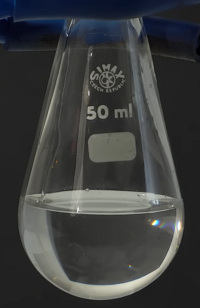
Photo from wikipedia
The major challenge in optical ceramic technology is the quality of the starting precursor powder for pressing, which is a key element in the optical ceramic industry. One express and… Click to show full abstract
The major challenge in optical ceramic technology is the quality of the starting precursor powder for pressing, which is a key element in the optical ceramic industry. One express and helpful technique for the estimation of powder quality is the estimation of the quantum yield of up-conversion luminescence; therefore precursor powders must exhibit high values of up-conversion luminescence efficiency. Single-phase solid solutions based on strontium fluoride doped with ytterbium and erbium were synthesised by co-precipitation from aqueous solutions using sodium fluoride, potassium fluoride and ammonium fluoride as fluorinating agents. The asymmetry of X-ray diffraction maxima indicated the presence of two populations of particles with the same chemical composition. The processes of extended flat particles' growth from smaller particles with a spherical morphology were revealed with transmission electron microscopy and X-ray diffraction. It was shown that when sodium fluoride and potassium fluoride were used they entered the crystal structure in an amount of 3-4 mol% and 1 mol%, respectively. The introduction of sodium and potassium led to an improvement in the sintering ability of particles and a significant increase in the particle size in ceramics by a factor of 5 and 2, respectively, in comparison with the use of ammonium fluoride. The quantum yield values of up-conversion luminescence at the level of tenths of a percent at a low pump power density of 0.1 W cm-2 were very high, which suggests that these synthetic techniques can be considered to be promising for the preparation of precursors of laser ceramics.
Journal Title: Dalton transactions
Year Published: 2022
Link to full text (if available)
Share on Social Media: Sign Up to like & get
recommendations!